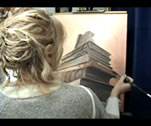This section provides a list of techniques, materials, and common references that are frequently used in the design and decorative painting profession.
A two-toned, patterned stone displaying ribbons of black undulations over a bright medium green background. It was extracted in abundance in Russia, and we can still admire many samples of tables, pedestal, statues, and columns in this country. It is highly attractive because of its unusually bright color and intricate design. Customarily it was set in gilded bronze and reserved to luxurious interiors that displayed equally unique accessories and furniture. The ideal destination of this faux would be for urns, lamp bases, inlaid panels or again a tabletop. You may also find it in combination with many other decorative stones, to create inlaid decors embellishing tops of tables or consoles for instance; these are named pietre dure.
As with many other faux finishes, artfulness and sobriety play important roles in affecting the observer's credibility of the imitated material. A Faux needs to evoke the natural material with its characteristic beauty; in the case of faux marble, only a careful study of marble with its graphic map will lead to success. For instance, a simulated Breccia marble asks for a well-proportioned distribution of the large fragments, or breches, to avoid visual heaviness. As a wall finish, organized slabs or panels will make the faux more credible; you will need to rely on real examples of cemented marble to imitate the joinery and the proportions of the sections. To avoid dullness of a repetitive pattern or color, using a combination of different types of marbles of different colors will create a surprise effect and achieve a refined look. There are many specimens of marbles or assimilated stones, and it is a pity that only a small handful of these are repeatedly reproduced.
A wide variety of metallic paints are readily available in stores, such as the Modern Masters brand. Metallic paints are viscous, medium, clear or opaque depending on the tints, bonding very well to metal or wood. Mixing metallic paints allows you to reach a more realistic effect and a less painted look. You can dilute the paint with an acrylic glaze, or Floetrol, and go over with different shades; however the dilution may cause a dullness in the color. To age a shiny gold, you may either slightly cover it with a pale brown glaze or a diluted bronze metallic paint. Instead of using a brush, gently dab a rag dipped into your dark medium. Metallic paint used as a background to a translucent glaze, gold, silver or bronze yields wonderful results. Also, in combination with a leopard or tortoise shell faux finish, they add a luxurious exotic and fun touch. These finishes are ideal for and work well on metal, and they prove to be very durable. To better protect a coat of metallic paint, you may seal it with an acrylic varnish.
Renzo Mongiardino was an exceedingly talented Italian architect, designer and painter, active in the sixties and seventies. He set interiors adorned with exuberant murals of gardens and Roman ruins, or rich oriental tented walls, lavishly furnished with plush furniture and first class accessories. His rooms are reminiscent of Yves Saint Laurent and Pierre Berge's homes, of the lavish and cozy Rothschild style, or again, of Nureyev's apartment. He owed his exquisite taste and erudition to his success, coupled with his thoroughly researched designs and impeccable execution. Nowadays, in a more exuberant vein, another Italian painter and designer, Carlo Marchiori, enlivens walls in California with Titanic murals and ravishing staged decors reflecting the furniture in fashion at the time of the mural's subject.






